Trends of Forest Harvesting Ages by Ownership and Function and the Effects of the Recent Changes of the Forest Law in Hungary
Abstract
1. Introduction
2. Materials and Methods
2.1. The Characteristics of Hungarian Forests
2.2. The National Forestry Database
2.3. The Method of the Analysis
- Hsomy: harmonic mean of harvesting ages of forest stands of tree species ‘s’, of ownership type ‘o’ and management purpose ‘m’, in year ‘y’;
- n: number of forest sub-compartments harvested in year ‘y’ of the tree species ‘s’, of ownership type ‘o’ and management purpose ‘m’;
- xi: harvesting age of forest sub-compartment ‘i’;
- wi: area of forest sub-compartment ‘i’.
- CAGE: trendline of the harmonic mean of the cutting ages as a function of the age;
- a, b: regression parameters;
- R2: determination coefficient.
3. Results
4. Discussion
5. Conclusions
Author Contributions
Funding
Data Availability Statement
Conflicts of Interest
Appendix A
| Sessile Oak | Pedunculate Oak | European Hornbeam | Ash | Other Broadleaved Species | Hybrid Poplars | Willows | Alders | Lindens | Scots Pine | Black Pine | Norway Spruce | |
|---|---|---|---|---|---|---|---|---|---|---|---|---|
| year | Private production forests | |||||||||||
| 2006 | 86 | 51 | 70 | 63 | 41 | 22 | 37 | 45 | NO | 35 | 39 | 31 |
| 2007 | 88 | 85 | 71 | 65 | 61 | 21 | 35 | 52 | NO | 37 | 32 | 33 |
| 2008 | 86 | 90 | 67 | 55 | 23 | 21 | 34 | 49 | NO | 34 | 26 | 40 |
| 2009 | 85 | 89 | 69 | 60 | 60 | 22 | 31 | 56 | NO | 40 | 36 | 33 |
| 2010 | 88 | 85 | 69 | 58 | 45 | 18 | 37 | 52 | 55 | 37 | 36 | 33 |
| 2011 | 87 | 98 | 70 | 75 | 40 | 19 | 34 | 53 | 67 | 40 | 42 | 33 |
| 2012 | 84 | 80 | 75 | 72 | 23 | 21 | 34 | 47 | 58 | 41 | 43 | 35 |
| 2013 | 89 | 85 | 73 | 54 | 51 | 21 | 34 | 40 | 66 | 39 | 46 | 36 |
| 2014 | 90 | 71 | 76 | 66 | 42 | 21 | 33 | 57 | 54 | 41 | 46 | 36 |
| 2015 | 86 | 92 | 80 | 54 | 28 | 21 | 36 | 56 | 68 | 42 | 42 | 36 |
| 2016 | 94 | 77 | 72 | 52 | 25 | 21 | 37 | 50 | 39 | 40 | 30 | 39 |
| 2017 | 55 | 83 | 71 | 40 | 65 | 21 | 39 | 56 | 74 | 40 | 42 | 39 |
| 2018 | 95 | 95 | 80 | 57 | 38 | 22 | 36 | 58 | 68 | 42 | 47 | 39 |
| 2019 | 93 | 97 | 72 | 49 | 49 | 21 | 36 | 52 | 64 | 43 | 42 | 38 |
| 2020 | 96 | 83 | 79 | 44 | 51 | 21 | 38 | 42 | NO | 45 | 46 | 39 |
| 2021 | 95 | 77 | 73 | 63 | 40 | 23 | 46 | 49 | 77 | 46 | 43 | 39 |
| Private forests, other management purpose | ||||||||||||
| 2006 | 97 | 71 | 85 | 58 | 42 | 27 | 38 | 55 | 41 | 40 | 57 | 40 |
| 2007 | 92 | 87 | 87 | 76 | 34 | 27 | 32 | 60 | 61 | 49 | 51 | 39 |
| 2008 | 93 | 79 | 95 | 59 | 31 | 27 | 41 | 41 | NO | 63 | 44 | 37 |
| 2009 | 48 | 70 | 86 | 20 | 44 | 27 | 44 | 61 | NO | 71 | 52 | 42 |
| 2010 | 94 | 87 | 95 | 44 | 52 | 24 | 39 | 63 | 57 | 78 | 51 | 50 |
| 2011 | 94 | 97 | 79 | 43 | 54 | 26 | 45 | 56 | 70 | 52 | 59 | 37 |
| 2012 | 95 | 89 | 71 | 53 | 49 | 28 | 37 | 45 | NO | 60 | 60 | 47 |
| 2013 | 94 | 78 | 80 | 57 | 45 | 27 | 43 | 61 | 72 | 55 | 51 | 38 |
| 2014 | 98 | 99 | 84 | 57 | 41 | 29 | 41 | 62 | 73 | 48 | 42 | 39 |
| 2015 | 99 | 80 | 76 | 57 | 51 | 31 | 42 | 60 | 52 | 56 | 41 | 38 |
| 2016 | 91 | 99 | 83 | 52 | 53 | 30 | 40 | 70 | 74 | 59 | 44 | 41 |
| 2017 | 101 | 101 | 78 | 79 | NO | 28 | 43 | 60 | NO | 52 | 45 | 42 |
| 2018 | 73 | 90 | 85 | 53 | 42 | 29 | 47 | 61 | 105 | 51 | 48 | 44 |
| 2019 | 96 | 101 | 84 | 22 | 54 | 29 | 41 | 66 | NO | 50 | 52 | 42 |
| 2020 | 101 | 107 | 85 | 31 | NO | 28 | 40 | 67 | NO | 58 | 46 | 40 |
| 2021 | 103 | 95 | 88 | 57 | 59 | 24 | 55 | 60 | NO | 57 | 44 | 41 |
| State-owned production forests | ||||||||||||
| 2006 | 84 | 87 | 75 | 48 | 24 | 23 | 32 | 55 | 83 | 43 | 44 | 32 |
| 2007 | 89 | 92 | 78 | 69 | 53 | 24 | 30 | 52 | 75 | 44 | 33 | 35 |
| 2008 | 90 | 95 | 79 | 68 | 47 | 22 | 30 | 55 | 72 | 46 | 43 | 37 |
| 2009 | 92 | 94 | 79 | 56 | 50 | 22 | 31 | 55 | 65 | 45 | 44 | 35 |
| 2010 | 92 | 92 | 74 | 52 | 33 | 23 | 30 | 56 | 69 | 44 | 47 | 38 |
| 2011 | 93 | 95 | 79 | 68 | 53 | 24 | 31 | 54 | 66 | 46 | 48 | 40 |
| 2012 | 93 | 93 | 83 | 56 | 49 | 24 | 35 | 52 | 77 | 48 | 46 | 37 |
| 2013 | 92 | 95 | 76 | 70 | 53 | 23 | 35 | 54 | 73 | 46 | 50 | 37 |
| 2014 | 91 | 95 | 78 | 70 | 64 | 25 | 38 | 57 | 77 | 47 | 52 | 38 |
| 2015 | 87 | 97 | 73 | 47 | 49 | 25 | 35 | 61 | 78 | 49 | 50 | 37 |
| 2016 | 93 | 95 | 81 | 62 | 54 | 25 | 36 | 60 | 73 | 41 | 49 | 37 |
| 2017 | 95 | 78 | 88 | 73 | 47 | 26 | 35 | 59 | 83 | 46 | 53 | 40 |
| 2018 | 95 | 95 | 87 | 55 | 69 | 26 | 34 | 54 | 77 | 48 | 52 | 38 |
| 2019 | 86 | 95 | 86 | 70 | 63 | 26 | 42 | 55 | 88 | 48 | 54 | 40 |
| 2020 | 90 | 85 | 84 | 67 | 48 | 27 | 35 | 62 | 95 | 49 | 53 | 40 |
| 2021 | 94 | 92 | 83 | 66 | 72 | 27 | 39 | 60 | 82 | 50 | 54 | 41 |
| State-owned forests, other management purpose | ||||||||||||
| 2006 | 96 | 91 | 74 | 68 | 67 | 26 | 31 | 56 | 82 | 52 | 62 | 45 |
| 2007 | 91 | 81 | 81 | 74 | 55 | 26 | 33 | 55 | 89 | 53 | 49 | 48 |
| 2008 | 93 | 92 | 80 | 74 | 61 | 27 | 36 | 59 | 98 | 53 | 51 | 48 |
| 2009 | 96 | 94 | 83 | 67 | 65 | 26 | 33 | 61 | 87 | 58 | 65 | 46 |
| 2010 | 94 | 95 | 79 | 68 | 66 | 24 | 33 | 47 | 82 | 62 | 55 | 51 |
| 2011 | 96 | 95 | 78 | 66 | 61 | 27 | 35 | 58 | 79 | 58 | 52 | 47 |
| 2012 | 95 | 97 | 82 | 74 | 69 | 27 | 36 | 57 | 85 | 59 | 57 | 50 |
| 2013 | 95 | 94 | 82 | 65 | 65 | 28 | 35 | 58 | 95 | 55 | 57 | 43 |
| 2014 | 92 | 100 | 81 | 83 | 58 | 29 | 37 | 56 | 83 | 55 | 58 | 43 |
| 2015 | 99 | 96 | 87 | 62 | 65 | 28 | 35 | 59 | 94 | 55 | 57 | 45 |
| 2016 | 97 | 102 | 81 | 70 | 57 | 29 | 37 | 59 | 99 | 53 | 57 | 48 |
| 2017 | 99 | 99 | 89 | 75 | 64 | 29 | 38 | 58 | 90 | 58 | 59 | 46 |
| 2018 | 98 | 96 | 81 | 71 | 64 | 31 | 41 | 60 | 84 | 61 | 57 | 43 |
| 2019 | 97 | 102 | 90 | 78 | 70 | 31 | 42 | 62 | 100 | 57 | 60 | 45 |
| 2020 | 101 | 101 | 81 | 64 | 70 | 30 | 42 | 60 | 99 | 62 | 60 | 45 |
| 2021 | 101 | 104 | 84 | 60 | 70 | 33 | 42 | 51 | 93 | 59 | 57 | 44 |
| Turkey Oak | Pedunculate Oak | Sessile Oak | European Beech | European Hornbeam | Black Locust | Ash | Other Broadleaved Species | Indigenous Poplars | Hybrid Poplars | Willows | Alders | Lindens | Scots Pine | Black Pine | Norway Spruce |
|---|---|---|---|---|---|---|---|---|---|---|---|---|---|---|---|
| Private production forests | |||||||||||||||
| I (0.66; 0.53) | x (0.06; 0.59) | x (0.02; 0.31) | I (0.54; 0.48) | x (0.35; 0.51) | D * (0.71; −0.29) | x (0.24; −0.97) | x (0.00; 0.00) | x (0.12; −0.24) | x (0.12; 0.08) | x (0.37; 0.42) | x (0.00; 0.05) | x (0.15; 1.18) | I (0.79; 0.60) | x (0.32; 0.74) | I (0.53; 0.44) |
| Private forests, other management purpose | |||||||||||||||
| x (0.26; 0.30) | I (0.51; 1.70) | x (0.08; 0.78) | x (0.00; −0.01) | x (0.04; −0.27) | D (0.71; −0.51) | x (0.03; −0.59) | x (0.40; 1.09) | x * (0.08; −0.32) | x (0.07; 0.11) | x (0.33; 0.61) | x (0.26; 0.79) | I (0.55; 3.28) | x (0.01; −0.16) | x (0.22; −0.59) | x (0.01; 0.06) |
| State−owned production forests | |||||||||||||||
| I (0.67; 0.40) | x (0.02; −0.14) | x (0.1; 0.21) | x (0.00; −0.04) | x (0.41; 0.60) | x (0.15; 0.04) | x (0.09; 0.53) | x (0.42; 1.66) | x (0.08; 0.15) | I (0.85; 0.32) | I (0.62; 0.59) | x (0.40; 0.42) | x (0.37; 1.01) | x (0.36; 0.31) | I (0.72; 0.94) | I (0.65; 0.40) |
| State−owned forests, other management purpose | |||||||||||||||
| I (0.56; 0.46) | I (0.65; 0.95) | I (0.59; 0.49) | x (0.01; 0.04) | x (0.34; 0.49) | x (0.01; 0.05) | x (0.02; −0.17) | x (0.18; 0.43) | x (0.14; −0.54) | I (0.82; 0.44) | I (0.83; 0.68) | x (0.06; 0.20) | x (0.21; 0.69) | x (0.25; 0.34) | x (0.07; 0.22) | x (0.22; −0.24) |
References
- Gunalay, Y.; Kula, E. Optimum cutting age for timber resources with carbon sequestration. Resour. Policy 2012, 37, 90–92. [Google Scholar] [CrossRef]
- Li, Y.; Luo, T.; Li, S.; Liu, B. Modeling Optimal Forest Rotation Age for Carbon Sequestration in the Great Khingan Mountains of Northeast China. Forests 2022, 13, 838. [Google Scholar] [CrossRef]
- Faustmann, M. Berechnung des wertes welchen waldboden sowie noch nich haubare Holzbestande für die Waldwirtschaft besitzen. Allg. Forst Und Jagd-Ztg. 1849, 25, 441–445. [Google Scholar]
- Heaps, T. Convergence of optimal harvesting policies to a normal forest. J. Econ. Dyn. Control. 2015, 54, 74–85. [Google Scholar] [CrossRef]
- Leslie, A.J. A Review of the Concept of the Normal Forest. Aust. For. 1966, 30, 139–147. [Google Scholar] [CrossRef]
- Suzuki, T. Gentan Probability and the Concept of the Normal Wood. Wide Sense 2003, 1, 65–74. [Google Scholar]
- Yoshimoto, A. A new stochastic model for harvesting behaviour with application to nonstationary forest growth and supply. Can. J. For. Res. 1996, 26, 1967–1972. [Google Scholar] [CrossRef]
- Yoshimoto, A. Economic analysis of harvesting behaviour using the modified Gentan probability theory. J. For. Res. 1996, 1, 67–72. [Google Scholar] [CrossRef]
- Király, L.; Szentkúti, F.; Gál, J.; Magas, L.; Mészáros, K.; Szélesy, M.; Facskó, F.; Rács, A.; Koller, E.; Szabó, P.; et al. Final Report of the nr. 1875. OTKA Research (1986–1991). In Establishing the Optimal Regulatory Strategy for Forest Management; University of Forestry and Wood Science: Sopron, Hungary, 1992. (In Hungarian) [Google Scholar]
- Király, L.; Mészáros, K. Konvergens Prognózisok Szerepe az Erdőgazdasági Stratégiák Tervezésében (Role of Convergent Prognosen in Planning Forestry); Erdészeti és Faipari Tudományos Közlemények; State of Japan’s Forests and Forest Management: Tokyo, Japan, 1995; p. 137.
- Hetemäki, L.; Hanewinkel, M.; Muys, B.; Ollikainen, M.; Palahí, M.; Trasobares, A. Leading the Way to a European Circular Bioeconomy Strategy. From Science to Policy; European Forest Institute: Joensuu, Finland, 2017; Volume 5. [Google Scholar] [CrossRef]
- Ranacher, L.; Lähtinen, K.; Järvinen, E.; Toppinen, A. Perceptions of the general public on forest sector responsibility: A survey related to ecosystem services and forest sector business impacts in four European countries. Forest Policy Econ. 2017, 78, 180–189. [Google Scholar] [CrossRef]
- Ranacher, L.; Sedmik, A.; Schwarzbauer, P. Public Perceptions of Forestry and the Forest-Based Bioeconomy in the European Union. In Knowledge to Action 3; European Forest Institute: Joensuu, Finland, 2020. [Google Scholar]
- Winkel, G.; Lovrić, M.; Muys, B.; Katila, P.; Lundhede, T.; Pecurul, M.; Pettenella, D.; Pipart, N.; Plieninger, T.; Prokofieva, I.; et al. Governing Europe’s forests for multiple ecosystem services: Opportunities, challenges, and policy options. For. Policy Econ. 2022, 145, 102849. [Google Scholar] [CrossRef]
- Seidl, R.; Thom, D.; Kautz, M.; Martin-Benito, D.; Peltoniemi, M.; Vacchiano, G.; Wild, J.; Ascoli, D.; Petr, M.; Honkaniemi, J.; et al. Forest disturbances under climate change. Nat. Clim. Chang. 2017, 7, 395–402. [Google Scholar] [CrossRef] [PubMed]
- Watson, J.E.M.; Evans, T.; Venter, O.; Williams, B.; Tulloch, A.; Stewart, C.; Thompson, I.; Ray, J.C.; Murray, K.; Salazar, A.; et al. The exceptional value of intact forest ecosystems. Nat. Ecol. Evol. 2018, 2, 599–610. [Google Scholar] [CrossRef] [PubMed]
- Hurmekoski, E.; Lovrić, M.; Lovrić, N.; Hetemäki, L.; Winkel, G. Frontiers of the forest-based bioeconomy—A European Delphi study. For. Policy Econ. 2019, 102, 86–99. [Google Scholar] [CrossRef]
- Navare, K.; Muys, B.; Vrancken, K.C.; Van Acker, K. Circular economy monitoring–how to make it apt for biological cycles? Resour. Conserv. Recycl. 2021, 170, 105563. [Google Scholar] [CrossRef]
- Verkerk, P.J.; Delacote, P.; Hurmekoski, E.; Kunttu, J.; Matthews, R.; Mäkipää, R.; Mosley, F.; Perugini, L.; Reyer, C.P.; Roe, S.; et al. Forest-Based Climate Change Mitigation and Adaptation in Europe. From Science to Policy 14; European Forest Institute: Joensuu, Finland, 2022; ISBN 978-952-7426-22-7. [Google Scholar]
- Goodman, R.C.; Herold, M. Why maintaining tropical forests is essential and urgent for a stable climate. In CDG Working Paper 385; Center for Global Development: Washington, DC, USA, 2014. [Google Scholar]
- Eggers, J.; Räty, M.; Öhman, K.; Snäll, T. How Well Do Stakeholder-Defined Forest Management Scenarios Balance Economic and Ecological Forest Values? Forests 2020, 11, 86. [Google Scholar] [CrossRef]
- Tausz, M. Using Forests to Manage Carbon: A Heated Debate; University of Birmingham: Birmingham, UK, 2017; Available online: https://www.birmingham.ac.uk/news/thebirminghambrief/items/2017/07/using-forests-to-manage-carbon.aspx (accessed on 3 January 2023).
- Favero, A.; Mendelsohn, R.; Sohngen, B. Using forests for climate mitigation: Sequester carbon or produce woody biomass? Clim. Chang. 2017, 144, 195–206. [Google Scholar] [CrossRef]
- Gorte, R.W. Carbon sequestration in forests. In CRS Report for Congress: Prepared for Members and Committees of Congress; CRS: Washington, DC, USA, 2009. [Google Scholar]
- Seidl, R.; Rammer, W.; Jäger, D.; Currie, W.S.; Lexer, M.J. Assessing trade-offs between carbon sequestration and timber production within a framework of multi-purpose forestry in Austria. For. Ecol. Manag. 2007, 248, 64–79. [Google Scholar] [CrossRef]
- Loisel, P. Under the risk of destructive event, are there differences between timber income based and carbon sequestration based silviculture? For. Policy Econ. 2020, 120, 102269. [Google Scholar] [CrossRef]
- Kula, E.; Gunalay, Y. Carbon sequestration, optimum forest rotation and their environmental impact. Environ. Impact Assess. Rev. 2012, 37, 18–22. [Google Scholar] [CrossRef]
- Romero, C.; Ros, V.; Daz-Balteiro, L. Optimal forest rotation age when carbon captured is considered: Theory and applications. J. Oper. Res. Soc. 1998, 49, 121–131. [Google Scholar] [CrossRef]
- van Kooten, G.C.; Binkley, C.S.; Delcourt, G. Effect of carbon taxes and subsidies on optimal forest rotation age and supply of carbon services. Am. J. Agric. Econ. 1995, 77, 365–374. [Google Scholar] [CrossRef]
- IPCC. Chapter 7 Agriculture, Forestry, and Other Land Uses (AFOLU). In Climate Change 2022: Mitigation of Climate Change, the Working Group III Contribution; Sixth Assessment Report; IPCC: Geneva, Switzerland, 2022. [Google Scholar]
- Hall, D.O.; Mynick, H.E.; Williams, R.H. Cooling the greenhouse with bioenergy. Nature 1991, 353, 1131–1140. [Google Scholar] [CrossRef]
- Pingoud, K.; Perälä, A.-L.; Soimakallio, S.; Pussinen, A. Greenhouse gas impacts of harvested wood products. In Evaluation and Development of Methods; VTT Tiedotteita Research Notes; VTT Tiedotteita: Espoo, Finland, 2003; p. 2189. [Google Scholar]
- Green, C.; Avitabile, V.; Farrell, E.P.; Byrne, K.A. Reporting harvested wood products in national greenhouse gas inventories: Implications for Ireland. Biomass Bioenergy 2006, 30, 105–114. [Google Scholar] [CrossRef]
- Geng, A.; Yang, H.; Chen, J.; Hong, Y. Review of carbon storage function of harvested wood products and the potential of wood substitution in greenhouse gas mitigation. For. Policy Econ. 2017, 85, 92–200. [Google Scholar] [CrossRef]
- Király, É.; Börcsök, Z.; Kocsis, Z.; Németh, G.; Polgár, A.; Borovics, A. Carbon Sequestration in Harvested Wood Products in Hungary an Estimation Based on the IPCC 2019 Refinement. Forests 2022, 13, 1809. [Google Scholar] [CrossRef]
- Creutzburg, L.; Lieberherr, E. To log or not to log? Actor preferences and networks in Swiss forest policy. For. Policy Econ. 2021, 125, 102395. [Google Scholar] [CrossRef]
- Nichiforel, L.; Keary, K.; Deuffic, P.; Weiss, G.; Thorsen, B.J.; Winkel, G.; Avdibegović, M.; Dobšinská, Z.; Feliciano, D.; Gatto, P.; et al. How private are Europe’s private forests? A comparative property rights analysis. Land Use Policy 2018, 76, 535–552. [Google Scholar] [CrossRef]
- European Commission. European Forest Strategy; European Commission: Brussels, Belgium, 2013. Available online: http://ec.europa.eu/agriculture/forest/strategy/ (accessed on 3 January 2023).
- Bouriaud, L.; Nichiforel, L.; Weiss, G.; Bajraktari, A.; Curovic, M.; Dobsinska, Z.; Glavonjic, P.; Jarský, V.; Sarvasova, Z.; Teder, M.; et al. Governance of private forests in Eastern and Central Europe: An analysis of forest harvesting and management rights. Ann. For. Res. 2013, 56, 3. [Google Scholar] [CrossRef]
- Brukas, V.; Sallnäs, O. Forest management plan as a policy instrument: Carrot, stick or sermon? Land Use Policy 2012, 29, 605–613. [Google Scholar] [CrossRef]
- Lawrence, A. Beyond the second generation: Towards adaptiveness in participatory forest management. CAB Rev. Perspect. Agric. Vet. Sci. Nutr. Nat. Resour. 2007, 2, 1–15. [Google Scholar] [CrossRef]
- Mermet, L.; Farcy, C. Contexts and concepts of forest planning in a diverse and contradictory world. For. Policy Econ. 2011, 13, 361–365. [Google Scholar] [CrossRef]
- Löfmarck, E.; Uggla, Y.; Lidskog, R. Freedom with what? Interpretations of responsibility in Swedish forestry practice. For. Policy Econ. 2017, 75, 34–40. [Google Scholar] [CrossRef]
- NFK. Summary Data on Forests in Hungary; National Land Centre, Forestry Department: Tokyo, Japan, 2021. Available online: https://nfk.gov.hu/Magyarorszag_erdeivel_kapcsolatos_adatok_news_513 (accessed on 3 January 2023).
- Hungarian Forest Act. 2023. Available online: https://net.jogtar.hu/jogszabaly?docid=a0900037.tv (accessed on 3 January 2023). (In Hungarian).
- Tobisch, T.; Kottek, P. Forestry-Related Databases of the Hungarian Forestry Directorate; Version 1.1.; NFCSO: Budapest, Hungary, 2013. [Google Scholar]
- Lam, F.C.; Hung, C.T.; Perrier, D.G. Estimation of variance for harmonic mean half-lives. J. Pharm. Sci. 1985, 74, 229–231. [Google Scholar] [CrossRef]
- Ministry of Agriculture of Hungary. Hungarian National Forest Strategy 2016–2030; Department of Forestry and Wildlife Management of the Ministry of Agriculture of Hungary: Budapest, Hungary, 2016; Available online: http://erdo-mezo.hu/wp-content/uploads/2016/10/nemzeti_erdostrategia_2016.pdf (accessed on 4 January 2023). (In Hungarian)
- Mátyás, C.; Berki, I.; Czúcz, B.; Gálos, B.; Móricz, N.; Rasztovits, E. Future of Beech in Southeast Europe from the Perspective of Evolutionary Ecology. Acta Silv. Lign. Hun. 2010, 6, 91–110. Available online: https://aslh.nyme.hu/fileadmin/dokumentumok/fmk/acta_silvatica/cikkek/Vol06-2010/08_matyas_et_al_p.pdf (accessed on 15 March 2023).
- Mátyás, C.; Berki, I.; Bidló, A.; Csóka, G.; Czimber, K.; Führer, E.; Gálos, B.; Gribovszki, Z.; Illés, G.; Hirka, A.; et al. Sustainability of Forest Cover under Climate Change on the Temperate-Continental Xeric Limits. Forests 2018, 9, 489. [Google Scholar] [CrossRef]
- Ujvári-Jármay, É.; Nagy, L.; Mátyás, C. The IUFRO 1964/68 inventory provenance trial of Norway spruce in Nyírjes, Hungary—Results and conclusions of five decades. Acta Silv. Lign. Hun. 2016, 12, 178. [Google Scholar] [CrossRef]
- Lakatos, F. Bark beetles on pine in Hungary. In Methodology of Forest Insect and Disease Survey in Central Europe; Foster, B., Knizek, M., Grodzki, W., Eds.; FAO: Rome, Italy, 1999; pp. 248–249. [Google Scholar]
- Nagy, I. Akácosaink és vágáskoruk. Áldás és átok? [Our black locust forests and their cutting age. A blessing and a curse?]. Erdészeti Lapok 2013, 148, 318–320. (In Hungarian) [Google Scholar]
- Buttoud, G.; Kouplevatskaya-Buttoud, I.; Slee, B.; Weiss, G. Barriers to institutional learning and innovations in the forest sector in Europe: Markets, policies and stakeholders. For. Policy Econ. 2011, 13, 124–131. [Google Scholar] [CrossRef]
- Kottek, P. National Forest Projection–2050; University of Sopron, Faculty of Forestry, VI. Faculty Scientific Conference Book of Abstracts; Bidló, A., Facskó, F., Eds.; Publishing Office of the University of Sopron: Sopron, Hungary, 2017; 59p. (In Hungarian) [Google Scholar]
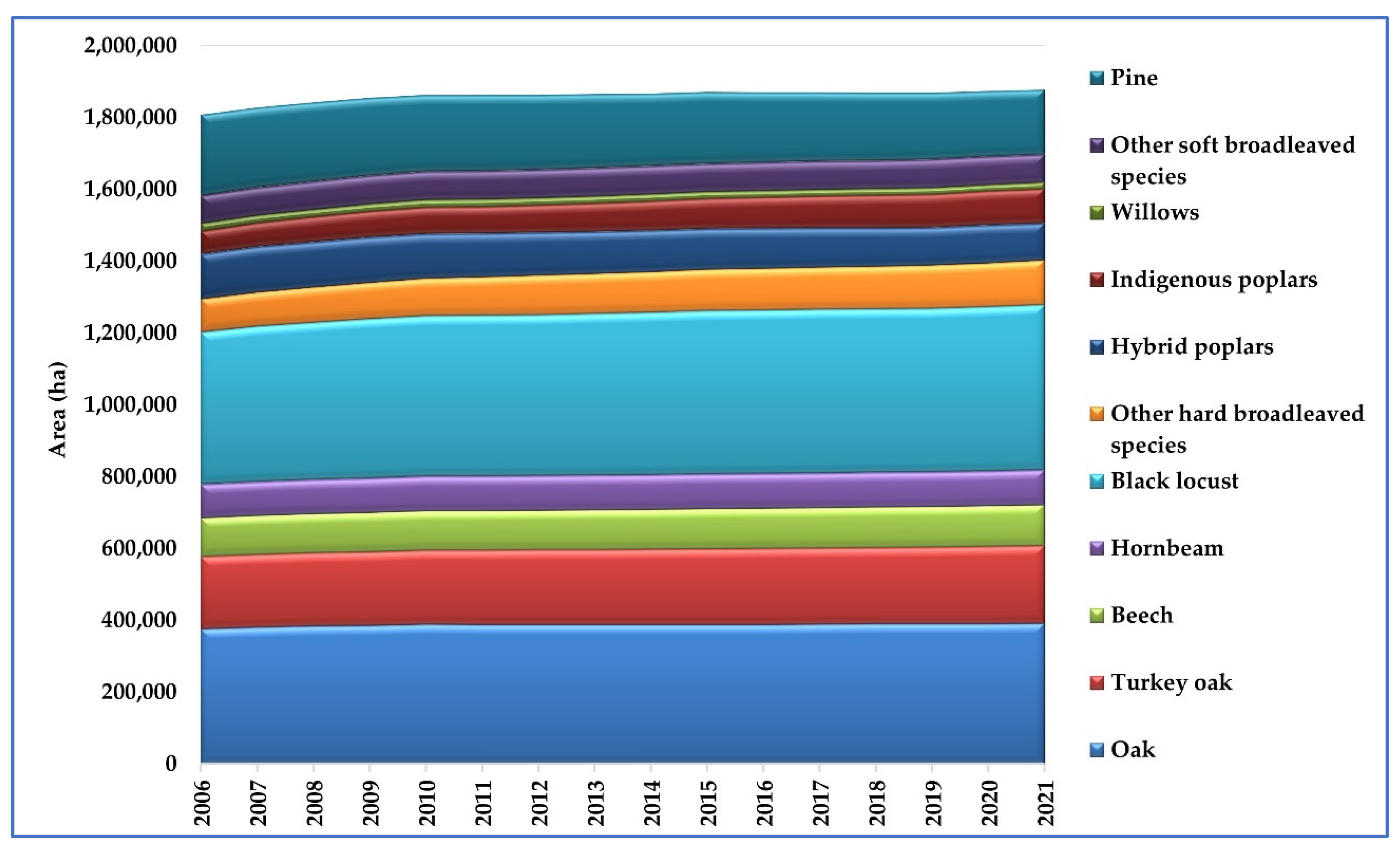
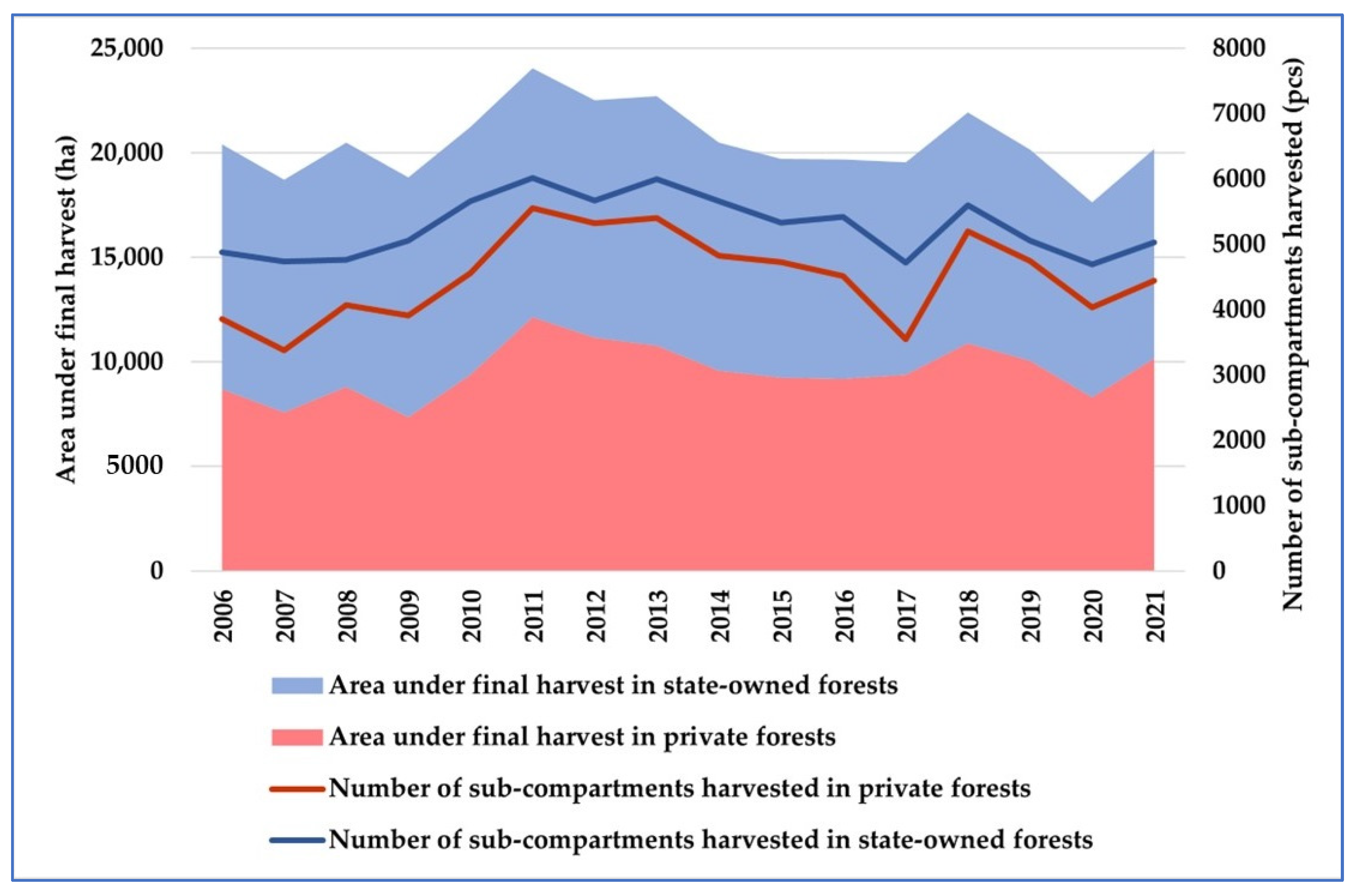
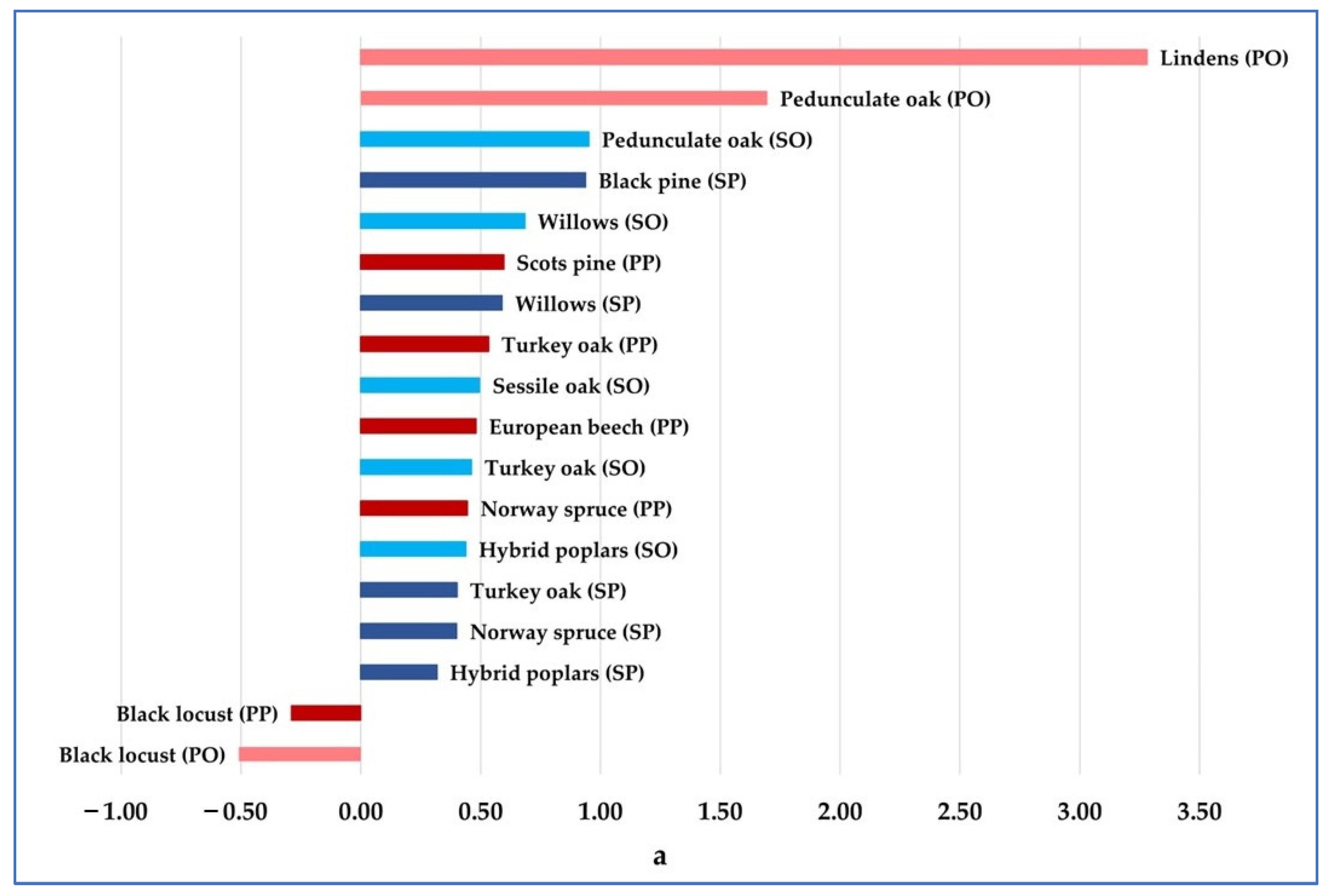
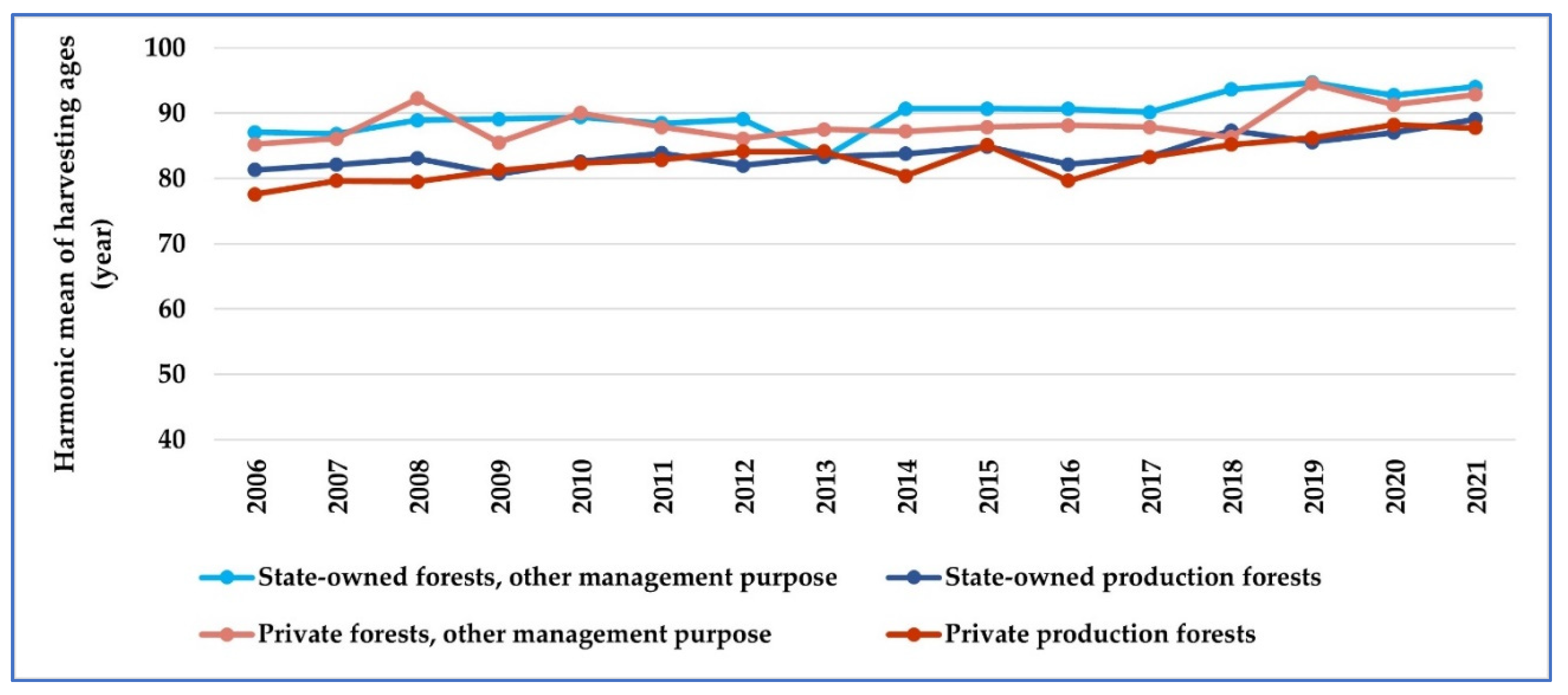

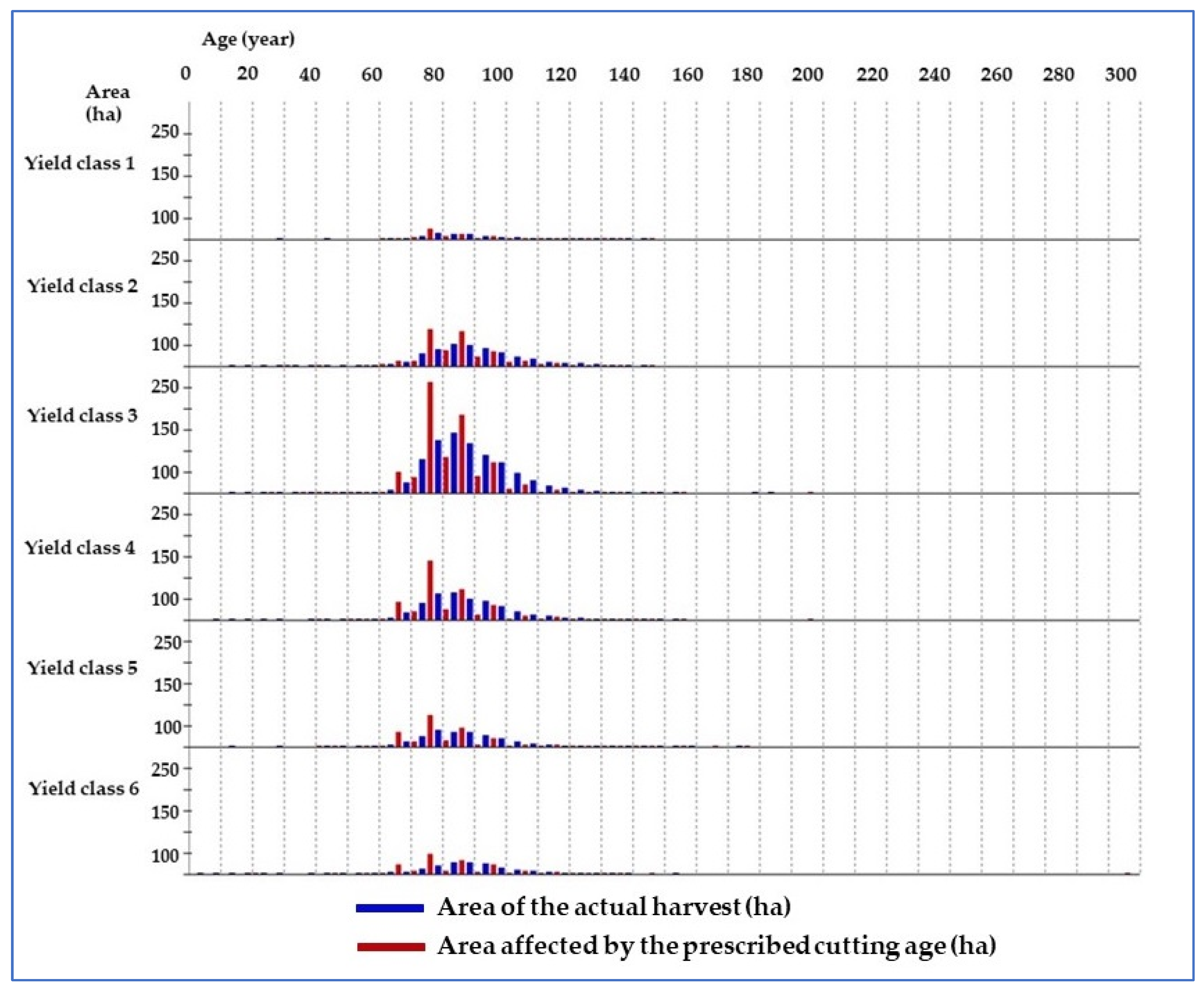

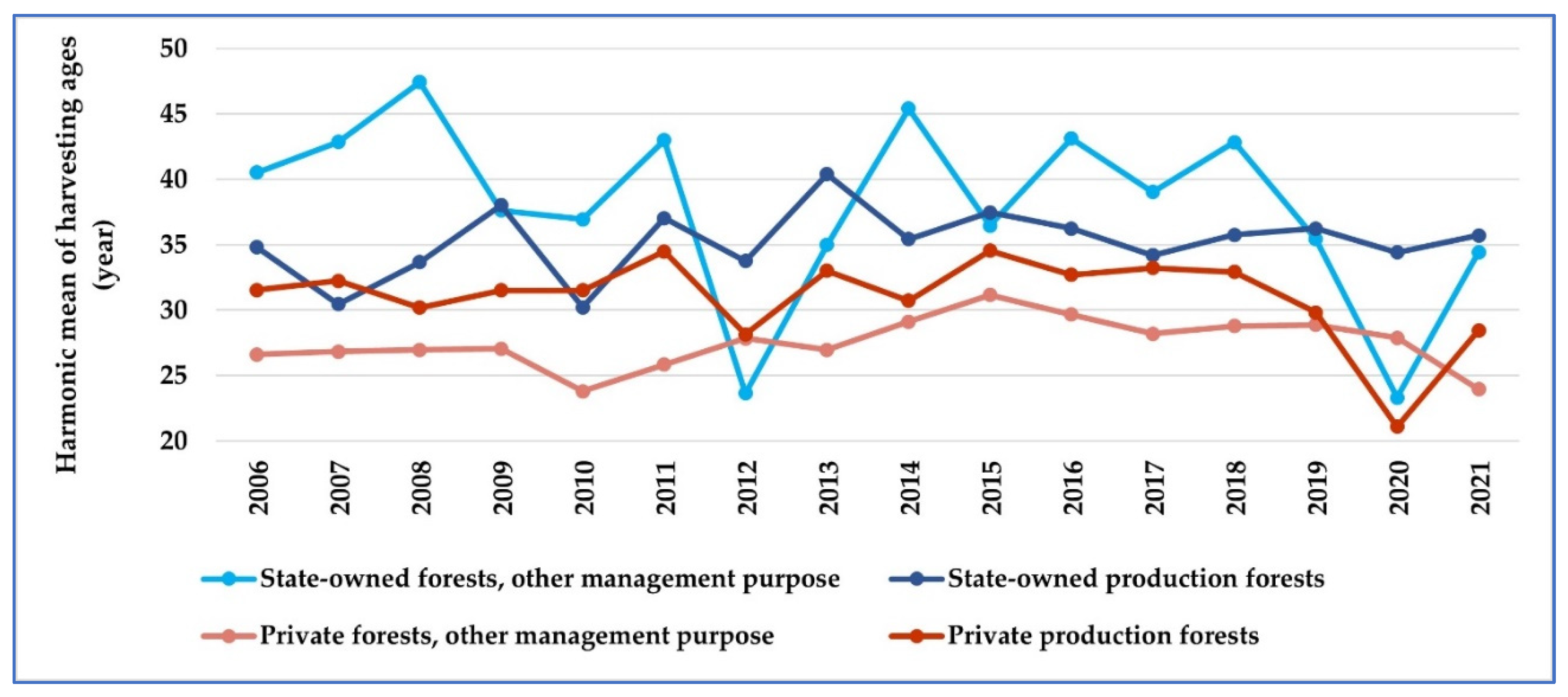
Disclaimer/Publisher’s Note: The statements, opinions and data contained in all publications are solely those of the individual author(s) and contributor(s) and not of MDPI and/or the editor(s). MDPI and/or the editor(s) disclaim responsibility for any injury to people or property resulting from any ideas, methods, instructions or products referred to in the content. |
© 2023 by the authors. Licensee MDPI, Basel, Switzerland. This article is an open access article distributed under the terms and conditions of the Creative Commons Attribution (CC BY) license (https://creativecommons.org/licenses/by/4.0/).
Share and Cite
Kottek, P.; Király, É.; Mertl, T.; Borovics, A. Trends of Forest Harvesting Ages by Ownership and Function and the Effects of the Recent Changes of the Forest Law in Hungary. Forests 2023, 14, 679. https://doi.org/10.3390/f14040679
Kottek P, Király É, Mertl T, Borovics A. Trends of Forest Harvesting Ages by Ownership and Function and the Effects of the Recent Changes of the Forest Law in Hungary. Forests. 2023; 14(4):679. https://doi.org/10.3390/f14040679
Chicago/Turabian StyleKottek, Péter, Éva Király, Tamás Mertl, and Attila Borovics. 2023. "Trends of Forest Harvesting Ages by Ownership and Function and the Effects of the Recent Changes of the Forest Law in Hungary" Forests 14, no. 4: 679. https://doi.org/10.3390/f14040679
APA StyleKottek, P., Király, É., Mertl, T., & Borovics, A. (2023). Trends of Forest Harvesting Ages by Ownership and Function and the Effects of the Recent Changes of the Forest Law in Hungary. Forests, 14(4), 679. https://doi.org/10.3390/f14040679






